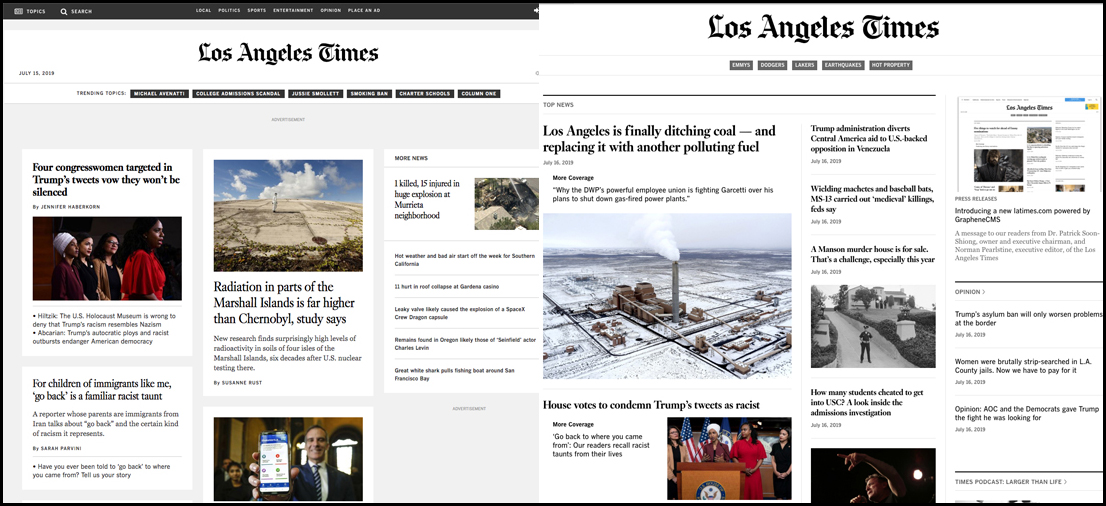
The LA Times has introduced changes to the front and backend of its website this year to improve reader experience, in the wake of significant digital subscription shortfalls this year.
In June 2019, a new-look LA Times website, together with its sister publication the San Diego Tribune, went live after a year-long discussion about how to improve functionality on the site.
"We were seeing rapid declines in search traffic and stunningly poor performance in load times," said digital editor, LA Times, Len De Groot.
"That’s unacceptable for any user. That kind of experience will not take advantage of reach, of people coming to our site, promoting circulation and hitting the paywall."
For LA Times, webpages were taking as long as 12 seconds to load previously, but could fluctuate depending on sizeable ads - such as takeover ads - and the time of day.
This has since been cut down to 30 per cent, to around four seconds, according to De Groot. Now under new local ownership since last year, the publisher is doing away with old ways of thinking around overcrowding platforms with ads.
"We had so many integrations where we had contracts with companies to provide advertising," he explained.
"At the beginning of the process we mapped it all out, years and years of tacking services on to provide one function and another. We looked at it and thought it was crazy."
These integrations have since been halved through consolidating publishing systems. The content management systems (CMS), assignments, media assets and archives are now all integrated within one content hub: GrapheneCMS.
The anger you may have read about this week in the @latimes newsroom is not because we don’t want to help attract new subscribers. Quite the opposite. We care deeply about our readers and want it to be easier for people to read and support our work. https://t.co/eVpOIAtAZb
— Laura J. Nelson 🦅 (@laura_nelson) August 2, 2019
The hub also powers a new iOS and Android mobile app, which amongst the features includes newsletters, multimedia content and a library of favourite stories.
Together, the plan is that by improving reader experience, more people will flock to the site, subscribe and, ultimately, retain their subscription as the publisher has found that keeping hold of paying readers has been a major issue.
Adjustments were also made to the general appearance and functionality of the site, with the biggest change coming to the white-on-grey ‘card’ articles before, versus a new-look simply white webpage.

"That created visual noise and is more difficult for the eye to scan without interruption, so we tried to pull as much of it as we could out and make sure audiences are not running into as many roadblocks.
"There were functional changes around the user experience. What we didn’t do is a deep change on furniture: the fonts, the headline typefaces and the body copy are all the same."
Since the handover process, the title was expecting a hit of traffic as the site was being reindexed. But De Groot claims the publisher has instead seen a sustained 25 per cent increase in Google search traffic - evidence, perhaps, that optimisation is working.
Going forward, he is looking at more ambitious projects, including a more comprehensive redesign of the website. For now and with a sharper back-end, there is room to look at new integrations with product partners Perfect Sense and YouTube.
In the coming months, reporters can upload content to the CMS, which will be directly uploaded to YouTube. An ID embed code is then generated which can be used straight away, even as the video is processing.
"This means something that is breaking, the minute we have a processed version of that video, even if it's a lowered rendered version, that embed code will be active," he explained.
"The benefit is we can drop an embed code as we’re processing. As we’re writing and editing the story, and as higher versions of the story become available, it automatically updates. That’s great for us for breaking news."
Want to know how to use breaking news to grow your audience? Find out how at Newsrewired on 27 November at Reuters, London. Head to newsrewired.com for the full agenda and tickets
This article was updated on 6 September 2019 by Jacob Granger. A previous version of this story reported that web load times were reduced by 30 per cent. This was corrected to report that web load times were reduced to 30 per cent.
Free daily newsletter
If you like our news and feature articles, you can sign up to receive our free daily (Mon-Fri) email newsletter (mobile friendly).









